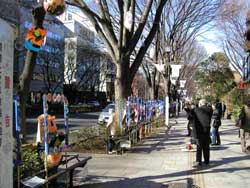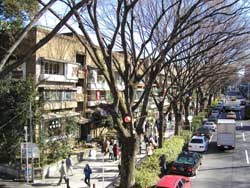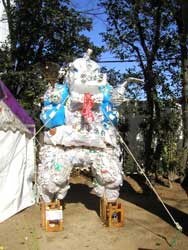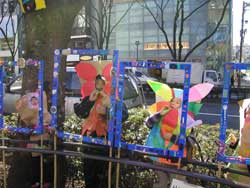MONTHLY NEWS Kids Hold Art Exhibition to Remember Old Buildings |
A famous old apartment complex in Tokyo is about to be demolished. Students from a nearby elementary school held an exhibition in January to preserve the memory of the buildings. They drew pictures and made other artwork, setting up the exhibition near the buildings and entertaining passers-by on one of Tokyo's most famous streets. The apartment complex, known as Dojunkai Aoyama, was built after the Great Kanto Earthquake of 1923 to provide housing for people who lost their homes in the quake. It is located on one of Tokyo's most fashionable streets, Omotesando. The buildings started out as public housing, but in recent years the number of residents has decreased, and the buildings have come to be occupied mostly by small art galleries and shops. The retro appearance of the complex goes well with the tall, shady zelkova trees planted along the boulevard, and the buildings and trees have together become known as a symbol of this stylish neighborhood.
Dojunkai apartments were built at 16 locations around Tokyo. They had many modern conveniences - such as flush toilets - that were new to Japan at the time, and in their early days they were places where many Tokyoites longed to live. But the complex on Omotesando has decayed badly in recent years, and in March of this year it will be demolished to make room for new buildings. Many people feel sad to see the old landmark go, and students from nearby Jingumae Elementary School wanted to be sure that it would live on in people's memories. So from January 15 to 26 the kids held an exhibition of drawings, sculptures, and other artwork they had created to honor the memory of the historic property. The art was displayed under and around the zelkova trees of Omotesando. The students had been preparing for the exhibition since last spring. They made drawings of the apartment buildings and cleaned up the area around each tree. To kick off the exhibition and to get the attention of passersby, a group of students all blew bubbles at the same time, filling the air with bubbles.
For the 12 days of the exhibition,
the tree-lined boulevard was decked with student artwork. A large sculpture
of Godzilla, made from trash by third-graders, was displayed near the
police station on Omotesando. Other art objects were displayed under
the zelkova trees. The students installed their picture frames on the
guard rails along the sidewalk. And t-shirts on which the students had
painted sunshine designs were hung on the streetlight posts.
The kids peered through the picture frames, which were decorated with a variety of materials, to become works of art themselves. One sixth-grade boy explained, "I like computers, so I made my frame with computer parts." Some of the frames had Yu-Gi-Oh trading cards plastered all over them, and others were decorated with pasta of various shapes glued neatly into a pattern. Commenting on the upcoming destruction of the old apartment blocks, one student said, "The landscape's going to change, and I'm sad about that." Another student commented, "I hope this exhibition will preserve the old buildings in people's memories." On weekends, Omotesando is packed with people who come to shop or just walk around, and the students' exhibition gave the visitors even more things to see than usual. Photos: (Top) Passers-by admire the students' artwork; (second) the Dojunkai Aoyama apartment complex; (third) the statue of Godzilla made by the kids; (bottom) the kids peer through the frames they made. |

|



